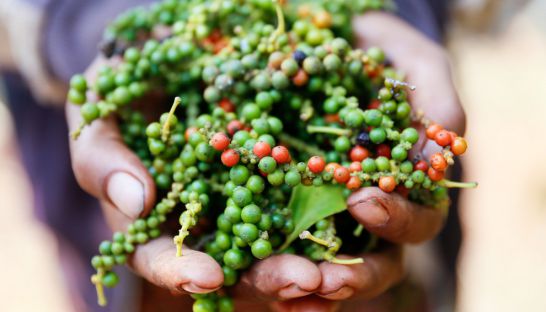Shaky outlook for black pepper
Shaky outlook for black pepper
The rapid expansion of pepper cultivation in Cambodia coincides with the spice’s plummeting world prices, creating concerns that the glut of pepper ripening on vines across the Kingdom could further erode next season’s market prices and push the sector toward a collapse.

Hean Vanhan, undersecretary of the Ministry of Agriculture, said large-scale planting in recent years, encouraged by the soaring prices, has significantly boosted Cambodia’s pepper production. He said total production doubled last year and has increased eight-fold since 2013, with the impact on supply magnified by similar output growth in other major pepper producing countries.
“According to our figures, the growth of pepper production has increased dramatically, but now the big concern for farmers is that the market has stagnated,” he said yesterday.
Ministry data show total pepper production rose to 20,054 tonnes this year, compared to 11,819 tonnes in 2016, and just 2,498 tonnes in 2013. More than 5,000 hectares are now cultivated with pepper, compared to just 400 hectares in 2013.
The vast majority of pepper production is in Tbong Khmum province, with nearly 15,000 tonnes last year. Smaller amounts are produced in Ratanakkiri and Kratie provinces, each contributing about 1,200 tonnes to the total.
Global pepper prices more than tripled between 2009 and 2015, sparking new investments into pepper farming and a rapid expansion of cultivation. However, prices have plummeted as Vietnam, the world’s top producer and exporter, continues to ramp up its production capacity.
The country, which accounts for about a third of global production, is projected to increase its output to more than 200,000 tonnes this year, from 175,000 tonnes in 2016.
Vanhan said rising supply and falling prices have pushed the sector to a critical juncture.
Domestic prices of black pepper in Cambodia, excluding GI-labelled Kampot pepper, have fallen by about 60 percent since a peak in 2014.“Cost and market have become critical issues and action must be taken immediately,” he said. “If not, the sector could collapse.”
He said the government and various relevant institutions should coordinate their efforts to promote Cambodian pepper in international markets and protect the sector, adding that local producers rely largely on Vietnamese brokers to purchase their crop and sell it to international buyers.
Var Rothsan, adviser to the Ministry of Commerce, said an oversupply of pepper was putting downward pressure on prices, with brokers offering local farmers as little as $3 per kilo for their crop – “well below the break-even point”.
He said that the ministry was aware of the challenges facing Cambodian pepper farmers and was working toward solutions.
“We know the problem and we are trying to provide the better facilities to farmers to have their own market, as well as decreasing the cost of production,” he said.
Rothsan added that the ministry was also working on developing a new collective trademark for Cambodian pepper aimed at raising the profile of locally produced, non-GI pepper in international markets – a move that could help reduce the reliance on Vietnamese brokers to access these markets.
“We need time to build up the confidence of consumers through a collective trademark, which will ensure the quality and food safety of our pepper,” he said, adding that the trademark’s launch could still be another two years off.
Yin Sopha, executive director for Memot Dar Pepper Agriculture Development Cooperative, said the domestic farm-gate price of black pepper had fallen to $3.5 per kilo, well below the 2014 high tide mark of $10.5 per kilo. He added that the decline was driving farmers deep into debt.
“The price has dropped drastically this year and most farmers cannot afford to pay the interest on their bank loans,” he said.


